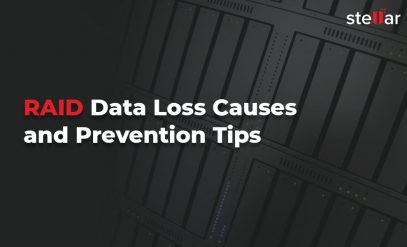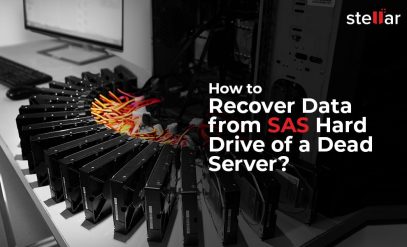Summary: Choosing the right storage system—DAS vs. NAS vs. SAN—depends on your organization’s performance, scalability, and cost needs. Understanding RAID levels and their benefits can help make an informed decision to ensure data protection and efficiency.
Introduction
Any organization must take storage into account, especially in this era of big data, artificial intelligence, and technology. Selecting a storage system depends on the size, complexity, and degree to which an organization uses and values its data. You must carefully balance and decide upon many factors, including costs, planned and actual storage capacity requirements, and scalability.
For an organization or business, there are three main possibilities for its data storage systems: DAS (Direct Attached Storage), NAS (Network Attached Storage), and SAN (Storage Area Network). Continue reading this post to know the major differences between SAN, NAS, and DAS and to choose the storage system that is ideal for you.
What is RAID Storage?
RAID, or redundant array of independent disks, is a system that distributes data across several hard drives to improve performance and/or provide fault tolerance. Businesses and individuals looking to safeguard their priceless data from hard disk failures commonly use RAID. There are various RAID levels, each with a unique combination of performance, fault tolerance, and storage capacity. While some RAID levels use parity data to restore lost data in the event of a disk failure, others use data mirroring across many drives to offer redundancy.
Types of Internal RAID Storage
The terms “levels” relate to typical RAID configurations; originally, there were five; however, today, there are many more. The main RAID levels are RAID 0, RAID 1, RAID 5, RAID 6, and RAID 10. Let’s examine these five RAID types:
1. RAID 0:
RAID 0 is not redundant. It stripes data across multiple drives to improve performance but offers no redundancy. If a single drive fails, all data in the array is lost. RAID 0, also known as striped volume or striped set, requires a minimum of two drives. The disks are merged into a single large volume, and data is evenly spread over all of the disks in the array. RAID 0 is frequently used to boost efficiency.
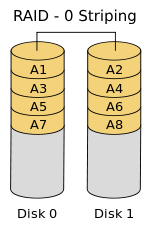
2. RAID 1:
RAID 1 is the best choice when redundancy and data protection are the primary goals. With this kind of RAID, your data is stored on one disk and in a separate copy on the other drives that are available. This suggests that even in the event of a drive failure, you will still be able to access your data.
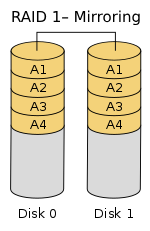
3. RAID 5:
Popular configuration that strikes a good compromise between performance and security. It offers quicker reading speeds but maintains the same write rates; it requires at least three disks. RAID 5 gives the arrays, which take up the same area as a single drive, additional consistency. In terms of failure tolerance, RAID 5 outperforms RAID 1 and RAID 0.
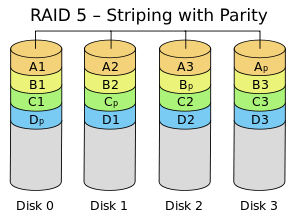
4. RAID 6:
Similar to RAID 5, RAID 6 distributes two additional parity blocks among the disks. As a result, block-level striping is used to disperse the data across the array, and two parity blocks are kept for every data block. RAID 6 has slower write performance than RAID 5 and RAID 0 due to the overhead of calculating and writing two parity blocks. This should be emphasized.
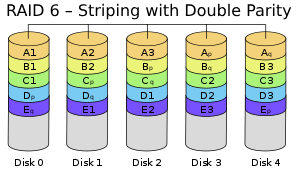
5. Raid 10:
RAID 10 combines components of RAID 0 (striping) and RAID 1 (mirroring) to offer the advantages of redundancy and performance. It treats numerous data storage devices (such as hard drives) as a single logical unit. Data is striped and replicated among the disks in the array, requiring a minimum of four disks.
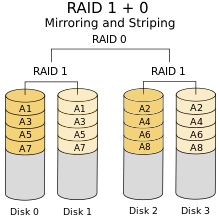
What is DAS?
DAS also includes external storage directly connected to a computer or server, such as external hard drives and USB drives. It takes the form of a Solid-State Drive (SSD) or Hard Disk Drive (HDD) plugged straight into the motherboard. Direct-attached storage devices also include external storage, such as external hard drives and USB (Universal Serial Bus) devices.
DAS can be used as private storage linked to dedicated servers in data centers and as file servers in small and medium-sized enterprises (SMBs). DAS is occasionally used alongside networked storage systems like SAN and NAS by larger businesses.
What is NAS?
Network-Attached Storage (NAS) system is a network-connected storage device that enables authorized network users and diverse clients to store and retrieve data from a centralized location. Because NAS systems are adaptable and flexible, you can expand them to accommodate more storage. NAS is comparable to having a personal cloud at work. It gives you total control and offers all the advantages of a public cloud on-site, but it’s also faster and less expensive.
What is SAN?
A computer network that offers access to centralized, block-level data storage is known as a Storage Area Network (SAN) or storage network. SANs allow servers to access shared storage at block level, providing the operating system the appearance of local storage but with the benefits of centralized management and scalability. Generally speaking, a SAN is a separate network of storage devices not connected to a Local Area Network (LAN).
DAS vs. NAS vs. SAN
Here are some key DAS vs NAS vs SAN points in the given table:
| Features | DAS | NAS | SAN |
|---|---|---|---|
| Connection | Directly attached to a solitary workstation or server. | Network-connected and reachable via Ethernet or Wi-Fi. | Linked to a network and reachable over iSCSI or a fiber channel. |
| Scalability | DAS scalability is limited compared to NAS and SAN, but external DAS solutions can still offer significant capacity by connecting multiple drives or enclosures. | Expandable with numerous units and scalable with extra drives. | It is easily expandable, allowing for the addition of more servers and storage as needed. |
| Management | Controlled by the linked computer or server. | Can be controlled centrally via an online interface. | Operated by storage management software and a dedicated storage network. |
| Performance | May operate at high speed when connected via SAS PCIe or other high-speed interfaces. | Network congestion may restrict performance, which is dependent on network speed. | Exceptional performance with iSCSI, fiber channel connectivity, and dedicated storage networks. |
| Expense | Comparatively inexpensive because it doesn't need any extra hardware. | Mid-range price with the need for extra hardware. | Expensive because specialized hardware and management software are required. |
| Use Case | Perfect for low-latency application needs and small-scale storage needs. | Perfect for file sharing and medium-sized storage requirements. | SANs are also used for applications requiring high performance, low latency, and large-scale storage beyond high availability and mission-critical functionalities. |
Factors to Consider in Choosing a RAID System
- Execution: You must select a RAID level that corresponds to your workload based on your application requirements. Your system’s applications have varying requirements. For example, some apps demand less I/O speed, while others need more. You must determine which is more important: data redundancy or improved performance.
- Information Security: Data redundancy is a key consideration when using RAID if you want to guarantee the least amount of downtime possible. Take into account the degree of data protection when selecting the RAID level. Not every level can guarantee less downtime and satisfy your needs for system availability.
- Ability: The net usable space provided by different RAID levels varies. There are differences in storage capacity among levels when RAID overhead is taken into consideration. Therefore, RAID 0 is a good option if usable capacity is your main concern, as it offers 100% usable storage on the drives.
- Price: Another significant consideration is the setup cost of a RAID array. As you are aware, quality is not inexpensive. You may need to spend extra if you want higher performance and capacity.
Choosing the Right RAID Level
RAID Level 1 offers enough security for most users. You will always have a backup copy of all your media with you. RAID 1 can offer improved read performance as data can be read from multiple disks simultaneously. Write performance is generally not improved because data must be written to both disks. But knowing that every single file on the volume has two copies will give you peace of mind.
RAID 5 is perfect for those looking for a balance between price, performance, and security. It’s also ideal for creative professionals, like Photoshop artists, video editors, and sound designers. You can increase your storage capacity, read and write speeds, and protection against a single disk failure by using a RAID 5 array of drives. However, choosing the best RAID level depends on your business.
Wrapping Up
We have covered DAS, NAS, and SAN storage options in this article. The user has a choice because each solution has a different feature set and works well for different use cases. By carefully assessing the needs for a dedicated storage solution, the desired feature set, performance, and scalability, users or organizations can choose the best storage option for their use case.
You can also check the related case study on the RAID server here:
FAQs
1. What makes DAS better than NAS?
Network connectivity is not required while using DAS, and numerous drives can be stored in a single enclosure with the correct enclosure.
2. What factors influence the data recovery cost?
The data recovery cost is influenced by factors such as the type of storage medium. For instance, a hard drive, SSD or RAID array. It also depends on the severity of damage or corruption and the size of the data to be recovered. The expertise required for the recovery process also plays a role in the overall cost.
3. What is the main difference between SAN and NAS storage?
SAN (Storage Area Network) provides block-level storage access over a dedicated network. NAS (Network Attached Storage) offers file-level storage access over a shared network.
4. Is NAS compatible with DAS?
While studying a NAS’s fundamentals, those unfamiliar with its operation can just utilize it as a DAS. Without needing to know anything about how a NAS operates, remote access is possible with the help of incredibly easy-to-use iOS and Android apps.
5. How do I find data recovery services near me?
You can search online using keywords like “data recovery services near me” on search engines like Google. You can also check local business directories for companies specializing in data recovery.

